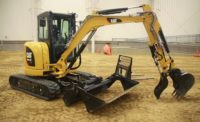 |
| Quick-coupling devices save labor and have made excavators more versatile. (Photo courtesy of Komatsu America Corp.) |
The U.S. Occupational Safety and Health Administration is considering updating an information bulletin issued in August that warned about the hazards of unexpected release of excavator buckets attached with new quick-coupling devices.
Contractors should be aware of the potential problem with the couplers when they are considering buying new machinery, says David Ippolito, director of OSHAs office of Service and Technology Assessment. "One of the issues they have to look at is who will be doing the connections, and how they should be trained," he says.
After another fatal accident last year involving a hydraulic excavator, OSHA staff reviewed accident data and found 15 incidents since January 1998 that involved the unanticipated release of excavator buckets from quick couplers on hydraulic excavators. Eight workers died in these incidents, according to OSHA's Safety and Health Information Bulletin.
Manufacturers that have added the quick-coupling feature use different methods for proprietary reasons, and operators are expected to know how to use them properly.
One accident in Wisconsin in the last year occurred at a site where a contractor was installing water mains and laterals. An excavation for a lateral had just been dug and an employee entered the lateral to prepare to install the pipe. The excavator operator changed buckets using a quick coupler on the hydraulic excavator. When the excavator was swung to continue digging on the main line, the bucket detached from the quick coupler and slid into the lateral excavation, hitting and killing the employee.
OSHAs investigation found that a locking pin had not been manually installed on the coupler to prevent accidental release of the attachment.
The OSHA bulletin urges employers using quick couplers to inspect them and take appropriate measures to prevent the unintended bucket releases, which can result in serious injuries or fatalities. But the best measure could be to ensure that workers are familiar with the proper use of the equipment, some industry insiders say.
With 24,000 excavators sold each year in North America, it may be easy for equipment users to become confused. With no standard coupling device and each machine capable of mounting two or three attachments, mistakes might be expected, some say.
"If you change from [using] a Cat to a John Deere, youre definitely going to have different couplers and some different safety measures to deal with. Theyre not all the same," says Chuck Yengst, president of Connecticut-based machinery market research firm Yengst Associates, Inc. "Two or three attachments go with each excavator. That begins to be quite a lot of attachments."
Frank Manfredi, an Illinois-based industry analyst and specialist in earth-moving equipment, says the market for the machinery has been growing steadily as contractors put versatile excavators to new uses. "They are using it for more than digging trenches," he says.
Whether the problems with couplers are widespread is not clear, he adds. "Its only been the past five years that these attachments have been important."
While a "pin-grabber," which is operated by the machine operator from the cab, is the most common type of coupling device, it is by no means universal, Manfredi says, noting that there are more than two dozen types of "crawler" excavators.
"A typical machine is sold with a bucket, and the other attachments can include hydraulic breakers, for breaking concrete; the three-pronged "thumb" attachment, used for picking up boulders and large objects; a vibrating plate for tamping earth; and a "pulverizer," which is used to crumble rebar-reinforced concrete in demolition projects."
Manufacturers have retrofitted existing quick couplers, designed new and improved quick coupler systems and developed safe use and operating procedures, the OSHA report concludes. "These corrective actions have significantly decreased the probability of a bucket or other attachment being unintentionally released from a quick coupler."
But not all employers and contractors using quick couplers are aware of the hazard and the manufacturers corrective actions, OSHA adds. "Some users fail to retrofit the quick coupler with locking pins; and some users have insufficient training on installation and testing procedures associated with the use of such couplers."
Some manufacturers have decided to retrofit their machines because of the problem, but OSHA is unsure if all manufacturers of excavators have done so, Ippolito says. "Were in the process of looking at the [safety bulletin] again, with relation to new information thats come to light. But nothing substantive has come to light that changes the accuracy of the safety bulletin," he says, adding that the revised document would likely be available to the public within the next several months.
An industry-wide standardization of coupling devices is unlikely, says Manfredi. "Each coupler manufacturer has a unique design and has patents on them," he says. Ippolito was more optimistic.
But with the industry booming, the possibility of such standardization still appears to be remote. "All heavy machinery [sales have] been up just a huge amount," says Yengst. "Last year, we had the biggest year in the history of the business."


Post a comment to this article
Report Abusive Comment